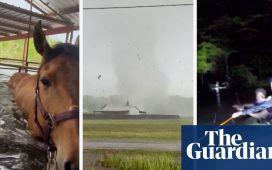When the remnants of Hurricane Ida swept into New York this month, the storm’s ferocity shocked the city. Even with meteorologists warning of intense rains and flooding, the swiftness with which the storm turned streets into rushing — and deadly — rivers caught officials and residents off guard.
New York has taken steps to prepare for the extreme weather driven by climate change. For years, particularly after Hurricane Sandy flooded much of the region, civic groups, environmental organizations and officials had raised alarms and urged action to protect from extreme storms.
But much of the post-Sandy work focused on flooding caused by rising waters surrounding the city’s shores. The rains brought by Ida — and two other storms this summer that deluged parts of the area — pose a different kind of threat: massive rainfall in a short period.
The storms exposed how New York City’s aging infrastructure — including its vital subway, built for a different climate — needs significant improvements to adapt to the kinds of storms that climate scientists say will be both more frequent and more intense.
Already, urban planners, climate scientists, some local officials and designers have a lengthy to-do list of design and engineering solutions that can help the city meet an urgent need. (Some say they have warned the city about extreme rainfall for years, pointing to past reports.)
Many experts, local elected officials and climate groups are now pressing more forcefully in the wake of a storm that they hope will serve as a wake-up. Here are some of their proposals.
Unclog drains and widen pipes. It’s not an easy task.
The most direct way to reduce flooding from rainfall is to drain it away more efficiently. But New York’s sewage pipes, some of which are more than a century old, were built for a smaller city with a cooler climate that generated less torrential rains.
Some 60 percent of the city is served by a combined sewage system that takes in both household wastewater and runoff from streets. Other cities have separate pipes for those two sources.
During heavy storms, New York’s pipes frequently overflow, backing up the system so that water cannot drain as fast as rain pours down.
The city spends hundreds of millions of dollars a year upgrading sewers, but the pace has not kept up with the changes in weather. Projects are underway to separate combined sewers in several flood-prone areas on the Brooklyn waterfront and parts of Queens on Jamaica Bay.
Still, one of the most immediate fixes for the sewage system is the simplest: better maintenance of existing drains and catch basins, the underground holding pens for water that can become clogged with leaves, mud or garbage.
The city’s Department of Environmental Protection responds to complaints about blocked drains, but officials say more staffing is needed to proactively unclog drains in vulnerable areas. Other state and city agencies are responsible for some drains, like those on highways.
Other measures that would reduce clogs from garbage include more frequent street sweeping and installing street-side containers to prevent household and commercial garbage bags from ripping or being torn by rats and spewing litter.
Some steps to better guard the city against climate change carry significant price tags, though experts say the cost of inaction would be even higher.
“Here we are, wringing our hands and saying it’s too expensive,” said Klaus Jacob, a geophysicist at Columbia University who has researched climate change and cities. “Well, it’s actually too expensive not to do the right things.”
Turn streets, parks and open spaces into sponges.
New York City has more than 6,000 miles of streets and 30,000 acres of parkland — the green spaces soak up countless gallons of rainwater, but the asphalt sends it sluicing onto the roadways and sidewalks. During particularly powerful storms that water cascades into homes, businesses and into the subway.
Infrastructure and public-space experts say the city needs to maximize surfaces to collect, absorb and slow down storm water.
“The challenge for us is to turn New York City into a sponge,” said Amy Chester, the managing director of Rebuild by Design, a nonprofit that works on making infrastructure more resilient to storms and climate change.
Take the streets. Experts say the city should expand a green infrastructure program that includes installing bioswales, or rain gardens — landscaped curbside areas planted with water-loving vegetation. Many cities across the country have used them to help reduce street flooding.
Experts say New York should use more water-permeable materials for its streets and sidewalks, which it has already started doing in flood-prone areas. The city has used Stormcrete, a more porous form of concrete, to reconstruct sidewalks in parts of Southeast Queens and incorporated stone instead of mortar in the joints between pavers to reduce storm water accumulation in Brooklyn.
“These projects weathered Tropical Storm Ida well, and we have plans for similar work,” said Christopher Browne, a spokesman for the city’s Department of Transportation.
The agency will soon operate a new network of flood walls and gates largely on city property to protect roads and neighborhoods from flooding. These are being constructed as part of a citywide flood protection system in areas like the Lower East Side of Manhattan that can be activated ahead of big storms.
Still, the city can do more, identifying how and where neighborhoods flood and redesign streets and other surfaces to direct storm-water runoff to parking lots, schoolyards, parks and even special retention tanks until it can go into the ground or drain into the sewer, said Franco Montalto, a civil and environmental engineering professor at Drexel University.
“It’s kind of like making streets into urban brooks to convey the water to places where it can safely pond without flooding people’s houses,” said Professor Montalto, who is also a member of a mayoral-appointed panel on climate change.
The city, which has adopted guidelines to ensure that public parks are designed and maintained to be more resilient to flooding, has worked on projects to absorb and collect storm water in parks and recreation areas, including basketball courts, and help them recover from flooding.
Since 2013, the Trust for Public Land, a conservation group, has partnered with the city to rebuild more than 40 playgrounds to absorb and collect storm water. Altogether, these playgrounds now collect more than 23.5 million gallons of storm water a year.
“That’s a proverbial drop in the bucket given the billions of gallons of storm water a year, but we need more of these small-scale solutions because every little bit helps,” said Carter Strickland, the New York state director for the trust.
The subway needs to plug leaks. But the M.T.A. can’t do it alone.
After Hurricane Sandy — which ravaged the subway system when corrosive saltwater flooded tunnels and damaged crucial equipment — the Metropolitan Transportation Authority launched a significant climate resiliency effort.
The agency has spent at least $2.6 billion to protect subway openings against flooding, replacing pumps and fortifying tunnels under the East River.
Those improvements have helped to an extent. Janno Lieber, the agency’s acting chairman, noted that the tunnels inundated by Sandy stayed dry or emptied quickly during Ida’s downpour.
But the agency’s efforts have focused largely on stations and tunnels in coastal and low-lying areas. Storms like Ida have revealed the need for a broader approach toward mitigating climate-driven flooding; many of the flooded stations were in higher elevations.
Water has long bedeviled New York’s subway system. It was designed with the knowledge that it would practically always be wet: The tunnels that wind through bedrock are surrounded by groundwater that seeps in.
Storm water mainly enters the subway through the staircases that bring riders underground and the ventilation grates that keep air circulating.
“The subway system cannot be made impervious to water,” Mr. Lieber said. “It’s a hollow system.”
Even on dry days, the system can pump out up to 14 million gallons of water, Mr. Lieber said. But its capacity is overwhelmed by the recent storms that quickly dumped inches of rain in hours.
Much of the water that inundated the system was overflow from the city’s sewage and drainage infrastructure, and the fixes that could help keep water from overwhelming the streets would also help keep the subway system from flooding. They would also aid the subway’s pumping system, which sends excess water into the city’s sewers.
But many urban planning and transit experts have encouraged an even more aggressive approach.
After a storm in July, the Regional Plan Association, an urban planning research and advocacy group, released an analysis that found that as many as one-fifth of subway entrances, more than 400 total, could be affected by significant flooding in a storm in which 3.5 inches of rain fell per hour. Ida dropped 3.15 inches of rain on Central Park in one hour.
“The system has been tested from this,” said Robert Freudenberg, the association’s vice president for energy and environment. “And we’ve found where the weaknesses are.”
Sarah M. Kaufman, the associate director at the Rudin Center for Transportation at New York University, said the transit authority needed to do a better job clearing its 418 miles of drains and troughs.
A report released last month by the M.T.A.’s inspector general found that at the authority’s targeted pace for cleaning drains — 150,000 linear feet a year — it would require 15 years to clean the entire system. Officials have said that they would move to clean drains on a four-year cycle.
Ms. Kaufman also encouraged city and state officials to think on a larger scale and take lessons from other cities facing similar issues. She pointed to Tokyo, which has built up its flood defenses in part by constructing gargantuan underground cisterns to capture runoff and has put floodgates at subway entrances.
Dr. Jacob, the Columbia geophysicist, suggested that New York could look to Taipei, Taiwan, where many subway entrances were raised slightly to keep out street-level flooding. (Doing this across New York’s subway would require accommodations for people with disabilities, an area where the system has traditionally lagged.)
Mr. Lieber said that the system was exploring raising some entrances. Engineers were also mulling ways to efficiently plug the vents or cover the grates through which water could pour. The transportation authority has already installed “flex gates,” waterproof barriers it can deploy to cover some subway entrances, at stations in traditional flood zones.
Still, any engineering solutions will be expensive for a system already facing financial burdens.

